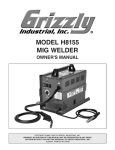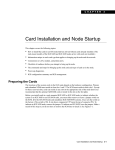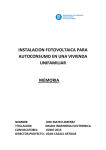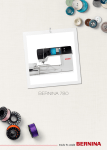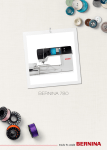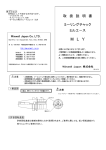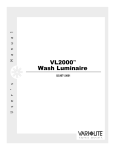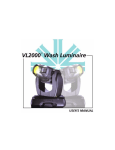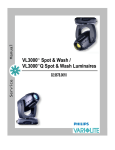Download Grizzly H8154 Welder User Manual
Transcript
MODEL H8154 AC/DC STICK/TIG WELDER OWNER'S MANUAL COPYRIGHT © MAY, 2007 BY GRIZZLY INDUSTRIAL, INC. WARNING: NO PORTION OF THIS MANUAL MAY BE REPRODUCED IN ANY SHAPE OR FORM WITHOUT THE WRITTEN APPROVAL OF GRIZZLY INDUSTRIAL, INC. #TS9402 PRINTED IN CHINA ����������������������������������������������������������������������� �������������������������������������������������������������� ���������������������������������������������������������������������� �������������������������������������������������������������������� ������������������������ ������������������������������������������������������������������ �������������������������������������������������������������������� ����������������������������������������������������������������� ���������������������������������������������������������������������� ��������������������������������������������������������������������� ����������������������������������������������������� ����������������������������������������������������������������������� �������������������������������������������������������������������� ����������������������������������������������������������������������� ������������������������������������������������������������������ ������������������������������������������������������������������� �������������������� �� ������������������������������������� �� ���������������������������� ������������������������������������������������������������������ ������������������������������������������������������������������ �������������������������������������������������������������������� ���������������������������������������������������������������������� ������������������������������������ Table of Contents INTRODUCTION ............................................................................................................................... 2 Foreword .................................................................................................................................... 2 Contact Info ................................................................................................................................ 2 Specifications ............................................................................................................................. 3 Identification ............................................................................................................................... 3 SECTION 1: SAFETY ....................................................................................................................... 4 Safety Instructions for Stick/TIG Welders .................................................................................. 4 Additional Sources for Welding Codes and Standards .............................................................. 6 SECTION 2: CIRCUIT REQUIREMENTS ........................................................................................ 7 220V Operation .......................................................................................................................... 7 Grounding for Welding Safety .................................................................................................... 8 SECTION 3: INVENTORY ................................................................................................................ 9 SECTION 4: OPERATIONS ........................................................................................................... 10 Operation Safety ...................................................................................................................... 10 Welder Duty Cycle ................................................................................................................... 10 Welder Controls ....................................................................................................................... 11 General Welding Operations .................................................................................................... 13 SECTION 5: ACCESSORIES ......................................................................................................... 14 SECTION 6: SERVICE ................................................................................................................... 15 Troubleshooting........................................................................................................................ 15 Replacement Parts & Labels ................................................................................................... 17 WARRANTY AND RETURNS ........................................................................................................ 21 INTRODUCTION Foreword Contact Info We are proud to offer the Model H8154 AC/DC Stick/TIG Welder. This machine is part of a growing Grizzly family of fine metalworking equipment. When used according to the guidelines set forth in this manual, you can expect years of trouble-free, enjoyable operation and proof of Grizzly’s commitment to customer satisfaction. If you have any comments regarding this manual, please write to us at the address below: The specifications, drawings, and photographs illustrated in this manual represent the Model H8154 when the manual was prepared. However, owing to Grizzly’s policy of continuous improvement, changes may be made at any time with no obligation on the part of Grizzly. For your convenience, we always keep current Grizzly manuals available on our website at www. grizzly.com. Any updates to your machine will be reflected in these manuals as soon as they are complete. Visit our site often to check for the latest updates to this manual! -2- Grizzly Industrial, Inc. /O Technical Documentation Manager P.O. Box 2069 Bellingham, WA 98227-2069 Email: [email protected] C We stand behind our machines. If you have any service questions or parts requests, please call or write us at the location listed below. Grizzly Industrial, Inc. 1203 Lycoming Mall Circle Muncy, PA 17756 Phone: (570) 546-9663 Fax: (800) 438-5901 E-Mail: [email protected] Web Site: http://www.grizzly.com H8154 AC/DC Stick/TIG Welder Specifications Stick Welding Current..............................5–130A Stick Duty Cycle .............................35% @ 130A AC TIG Welding Current .......................20–160A AC TIG Duty Cycle .........................35% @ 160A AC TIG Square Wave Balance .............. 30–70% AC TIG Square Wave Frequency ........20-100Hz DC TIG Welding Current .........................5–160A DC TIG Duty Cycle .........................35% @ 160A DC TIG Current Upslope .........................0.2 sec. DC TIG Current Downslope ................. 1-10 sec. TIG Gas Pre-Flow ................................0–10 sec. TIG Gas Post-Flow ...............................1–25 sec. Power Consumption ................23.8A @ 220VAC Output Power .....................................60–80VDC Length/Width/Height ..................... 21 x 9 x 16 in. Net Weight .................................................22 lbs. M L O Figure 2. Model H8154 front connections. L. M. N. O. Positive Output Socket Negative Output Socket Remote Control Connection Gas Outlet Connection Identification D A B N P T E C S F Q R Figure 3. Model H8154 features on back of welder. K J I H G Figure 1. Model H8154 control panel. A. B. C. D. E. F. G. H. I. J. K. Output Current Dial Square Wave Balance Dial Downslope Current Dial Power Light Warning Light Post-Flow Time Dial Welding Current LED Readout Stick/TIG Selector 2-Step/4-Step Selector AC/DC Selector Pre-Flow Time Dial H8154 AC/DC Stick/TIG Welder P. Q. R. S. T. Power ON/OFF Switch Gas Inlet Connection Power Cord Welder Enclosure Ground Terminal Cooling Fan and Cover -3- ����������������� �������������������������������������� ������������������������������������ �������������������������������������������������������������������������������������������������� �������������������������������������������������������������������������������������������� �������������������������������������������������������������������������������������������� �������������������������������������������������������������������������������������������� �������������������� ������������������������������������������������������������������� ��������������������������������������� ������������������������������������������������������������������� ���������������������������������������� ������������������������������������������������������������������� ��������������������������������������������������������������������� ������������������������� ������ ������������������������������������������������������������������ �������������������������������� ��������������������������������� Safety Instructions for Stick/TIG Welders ��� ������� ���� �������� ����������� ���� ������������������������������� 1. ����������������������������������� ����� �������� ������� �������� ���������� READ THIS MANUAL. This ��� manual con������� tains proper operating and safety proce- dures for this equipment. ��� ������� ���� ����� ��������� ������������������������������� 2. WELDING FUMES. Breathing welding ����������� ��������� ����������� ����� fumes can cause suffocation or poisoning ����� ������� ���������� ������������ ���� without warning. Keep your head out of ������������������� welding fumes. Use adequate ventilation at the arc to safely�� remove the fumes from ��� ������� ����� ������ ��������� your breathing zone and the general area. ����������� ����� ���������� Use ANSI approved respirators for the type ���������� ����� ��������� ������ of welding operation. Protect others from ����� ����� ���� ������ ������� ������������ these fumes. ���������� -4- 3. ����� ���������� ����������� ���������� ������ ���� ������ ���������� WELDING IN A CONFINED SPACE CAN �������������� BE HAZARDOUS. Always open all covers, sustain forced ventilation, remove toxic and ��� ����� ������� ��������� ��� ���� hazardous materials, and provide a power ���������������������������������������������� disconnect to the inside the������� work ��� �������� ����� ����welder ������ ��� ������� space. Always work with someone who ����� ����������� ����� ��������� ��� �������� can give you help from outside the space. ������������������������������������� Welding can displace oxygen. Always check safe breathing atmosphere and provide ��� for ������ �������� ���������� ����� air-supplied respirators if necessary. Keep �������������������������������� in mind that all normal welding hazards are ������������������������������������ intensified in a confined space. ������������������������������������ H8154 AC/DC Stick/TIG Welder 4. ELECTRIC SHOCK. DO NOT touch live electrical parts. Connect welder to power source with approved earth ground. Make sure all electrical connections are tight, clean, and dry. Connect workpiece to approved earth ground. The work lead is NOT a ground connection and is to be used only to complete the working welding circuit. 5. PREVENT FIRES. Welding work zones must be kept clear of flammable liquids, such as gasoline and solvents; combustible solids, such as paper and wood; and flammable gases, such as acetylene and hydrogen. Provide approved fire barriers and fire extinguishing equipment for the welding zone. Stay alert for sparks and spatter thrown into cracks and crevices that can start a smoldering fire. 6. 7. 8. PERSONAL PROTECTIVE EQUIPMENT. Wear eye, ear, and body protection approved for welding operations. Wear complete body protection, such as clean and oil-free protective clothing, leather gloves, protective cap, heavy long-sleeve shirt, cuffless pants, and high leather boots. DO NOT wear jewelry or frayed clothing. Use a welding helmet with correct shade of filter for the operation. Protect other people and property in your working zone from exposure to arc radiation, sparks, and spatter. WORKING AREA. Keep working area clear of any material not involved in the welding operation. Keep all equipment, workpieces, and work surfaces clean, dry, and free of entanglements. Keep lead cables organized and away from your body. AVOID EXPLOSION HAZARD. Never weld on closed containers or containers with fumes inside. Containers should be prepared per American Welding Society Publication F4.1, Section 7. H8154 AC/DC Stick/TIG Welder 9. HANDLING GAS CYLINDERS. Regardless of content, pressurized gas cylinders can explode. Always secure a protector cap in place over the outlet valve assembly when moving the cylinder. A broken off valve could release the pressurized contents and cause the cylinder to be hurled about at dangerously high speeds, causing serious property damage, personal injury, or death. Always use safe methods when moving gas cylinders. Always secure a gas cylinder to a wall or approved cylinder cart with a chain before using or storing. 10. PROTECT GAS CYLINDERS FROM HEAT OR DAMAGE. An excess of heat can cause the pressurized gas to expand and explode the cylinder. Never weld on the gas cylinder. Damaging the outside of the cylinder can cause the cylinder to crack and explode. Exploding pressurized gas cylinders can cause serious property damage, personal injury, or death. 11. ELECTRIC AND MAGNETIC FIELDS (EMF). Welding operations create EMF around the welding equipment and workpieces. Workers who have pacemakers must consult with their physician before using this equipment or being within 50 feet of welding operations. 12. EQUIPMENT MAINTENANCE. Make sure equipment inspections and maintenance are performed by a qualified person as required. Stop the welding operation and disconnect the welder from power if the equipment is damaged or malfunctions. 13. EXPERIENCING DIFFICULTIES. If you are experiencing difficulties performing the intended operation, stop using the equipment. Contact our Technical Support Department at (570) 546-9663. -5- Additional Sources Additional Sources for Welding Codes and Standards American Welding Society, 550 N.W. LeJeune Road, Miami, FL 33126, (305) 443-9353, Website: www. aws.org. —Safety in welding, Cutting, and Allied Processes, ANSI Standard Z49.1 —Recommended Safe Practices for the Preparation for Welding and Cutting of Containers and Piping, AWS F4.1 National Fire Protection Association, P. O. Box 9101, 1 Battery March Park, Quincy, MA 02269-9101, (617) 770-3000, Website: www.nfpa.org and www.sparky.org. —National Electrical Code, NFPA Standard 70 —Standard for Fire Prevention During Welding, Cutting, and Other Hot Work, NFPA Standard 51B Compressed Gas Association, 1735 Jefferson Davis Highway, Suite 1004, Arlington, VA 22202-4102, (703) 412-0900, Website: www.cganet.com. —Safe Handling of Compressed Gases in Cylinders, CGA Pamphlet P-1 Canadian Standards Association, Standards Sales, 178 Rexdale Boulevard, Rexdale, Ontario, Canada M9W 1R3, (800) 463-6727, Website: www.csa-international.org. —Code for Safety in Welding and Cutting, CSA Standard W117.2 American National Standards Institute (ANSI), 11 West 42nd Street, New York, NY 10036-8002, (212) 6424900, Website: www.ansi.org. —Practice for Occupational and Educational Eye and Face Protection, ANSI Standard Z87.1 U. S. Government Printing Office, Superintendent of Documents, P. O. Box 371954, Pittsburgh, PA 15250 (312) 353-2220, Website: www.osha.gov. —OSHA, Occupational Safety and Health Standards for General Industry, Title 29, Code of Federal Regulations (CFR), Part 1910, Subpart Q, and Part 1929, Subpart J American Conference of Government Industrial Hygienists (ACGIH), 1330 Kemper Meadow Drive, Suite 600, Cincinnati, OH 45240-1634, (513) 742-2020, Website: www.acgih.org. —Threshold Limit Values (Booklet) Like all equipment there is potential danger when operating this welder. Accidents are frequently caused by lack of familiarity or failure to pay attention. Use this welder with respect and caution to lessen the possibility of operator injury. If normal safety precautions are overlooked or ignored, serious personal injury may occur. -6- No list of safety guidelines can be complete. Every shop environment is different. Always consider safety first, as it applies to your individual working conditions. Use this and other equipment with caution and respect. Failure to do so could result in serious personal injury, damage to equipment, or poor work results. H8154 AC/DC Stick/TIG Welder Circuit Requirements SECTION 2: CIRCUIT REQUIREMENTS 220V Operation Serious personal injury could occur if you connect the machine to the power source before you have completed the set up process. DO NOT connect the machine to the power source until instructed to do so. Grounding In the event of an electrical short, grounding reduces the risk of electric shock. The grounding wire in the power cord must be properly connected to the grounding prong on the plug; likewise, the outlet must be properly installed and grounded. All electrical connections must be made in accordance with local codes and ordinances. Electrocution or fire could result if this machine is not grounded correctly or if your electrical configuration does not comply with local and state codes. Ensure compliance by checking with a qualified electrician! Amperage Draw The Model H8154 welder draws the following amps under maximum load: Draw at 220V, Single Phase ............... 23.8 Amps Circuit Requirements Connect your welder to a dedicated and grounded circuit that is rated for the amperage given below. Never replace a circuit breaker on an existing circuit with one of higher amperage without consulting a qualified electrician to ensure compliance with wiring codes. If you are unsure about the wiring codes in your area or you plan to connect your machine to a shared circuit, consult a qualified electrician. Minimum 220V Circuit Requirement ..... 30 Amps Plug/Receptacle Type Recommended Plug/Receptacle....NEMA L6-30 Extension Cords We do not recommend the use of extension cords. Instead, arrange the placement of your equipment and the installed wiring to eliminate the need for extension cords. If you find it absolutely necessary to use an extension cord at 220V with your machine: • Use at least a 10 gauge cord that does not exceed 50 feet in length. • The extension cord must also contain a ground wire and plug pin. • A qualified electrician MUST size cords over 50 feet long to prevent damage to the welder. Figure 4. NEMA L6-30 plug and receptacle. H8154 AC/DC Stick/TIG Welder -7- Grounding for Welding Safety There are two or more electrical circuits involved in any welding operation. The practice of safely grounding these circuits is documented in various codes and standards (refer to Additional Sources for Welding Codes and Standards on Page 6). Welding Machine Ground When properly connected to a power source, the Model H8154 welder is grounded through the power cord and local power grid. The internal welding circuit of the welder is insulated from the external enclosure. However, to avoid shocking hazards if this internal insulation fails, you must establish a separate earth ground for the welder's external enclosure. This ground will ensure that if a short does occur and the metal enclosure becomes integrated with the welding current, the current will safely dissipate directly through the ground instead of through you. Note: Refer to the publication NFPA 70, National Electric Code, Article 250, Grounding, and your local electrical codes for the correct method of establishing this ground. The grounding terminal for the H8154 external enclosure is located on the left rear of the welder (see Figure 5). Figure 5. Location of external enclosure grounding terminal on the rear of the Model H8154. -8- Workpiece Ground The incoming power circuit to the welder and the working welding circuit are two separate circuits that must have separate grounds. The welding circuit consists of the internal components of the welder, the welding cables, the electrode holder/torch assembly, the work clamp, and the workpiece. ANSI Welding Standards (Z49.1, 11.3.2.1) specify that "Grounding [of the workpiece] shall be done by locating the work on a grounded metal floor or platen, or by connection to a grounded building frame or other satisfactory ground." Always ensure that the ground for the incoming power circuit to the welder and the ground for the working welding circuit are never connected. Failure to comply with this warning could result in death, serious personal injury, or property damage. You must also avoid "double grounding" the workpiece. ANSI Z49.1 states that "Care shall be taken to avoid the flow of welding current through a connection intended only for safety grounding since the welding current may be of a higher magnitude than the grounding conductor can safely carry." Note: The work lead from the welder is sometimes incorrectly referred to as the "ground lead." The work lead from the welder is NOT a ground. The work lead and the ground connection to the workpiece are separate and must NOT be connected in any way. TIG welders use a high frequency current that creates a high electro-magnetic field (EMF) around the welder. EMF disrupts electronic devices. To avoid damage, keep electronic devices at least 50 feet from the welder when it is powered on. Workers who have pacemakers must consult with their physician before using this equipment or being within 50 feet of welding operations. H8154 AC/DC Stick/TIG Welder SECTION 3: INVENTORY The Model H8154 was carefully packed when it left our warehouse. If you discover the machine is damaged or a part is missing after you have signed for delivery, please immediately call Customer Service at (570) 546-9663 for advice. Save the containers and all packing materials for possible inspection by the carrier or its agent. Otherwise, filing a freight claim can be difficult. When you are completely satisfied with the condition of your shipment, inventory the contents. B A C F K E D J G H I Figure 6. Model H8154 inventory. A. B. C. D. E. F. Model H8154 AC/DC Stick/TIG Welder Gas Nozzles (#4, #5, and #6) Collets (1.6, 1.8, and 2.0mm) Collet Body Small Collet Backcap Long Collet Backcap H8154 AC/DC Stick/TIG Welder G. H. I. J. Work Clamp and Cable Stick Electrode Clamp and Cable Gas Tubing (Inlet) TIG Torch Assembly, Cable, Gas Tubing, and Torch Remote Control K. Foot Remote Control -9- SECTION 4: OPERATIONS Operation Safety Damage to your eyes and lungs could result from using this machine without proper protective gear. Always wear safety glasses, welder's helmet, and a respirator when operating this welder. NOTICE If you have never used this type of machine or equipment before, WE STRONGLY RECOMMEND that you read books, trade magazines, or get formal training before beginning any projects. Regardless of the content in this section, Grizzly Industrial will not be held liable for accidents caused by lack of training. Welder Duty Cycle As the welder produces the desired power output for the welding operation, some of the power is converted to heat. In order to protect the welder components from over-heating, each welder has an established duty cycle. The duty cycle is variable depending upon the amperage output being used. -10- A duty cycle is the number of minutes out of 10 minutes that the welder can safely operate at the current amperage output without over-heating. For instance, the Model H8154 has a stick duty cycle of 35% at 130A output. This means that the welder can operate continuously for 3.5 minutes at 130A output, then the arc must be stopped for at least 6.5 minutes to allow the welder to cool off before starting the arc again. It is important to leave the main power to the welder ON so that the cooling fan can speed the cooling process. The Model H8154 operates with an efficient cooling fan (at the rear of the welder) and has an internal thermostat that will shut the welder down if the maximum duty cycle has been reached. Shutdown will be evident by the loss of welding circuit and the illumination of the yellow warning light on the face of the welder. When the welder has cooled sufficiently, the internal thermostat will re-establish the welding circuit and the yellow warning light will go out. Note: Most electrodes used with stick welding are consumed within a few minutes, so the welder has a chance to cool down when the welding circuit is stopped to install a new electrode. However, with TIG welding, the operator needs to plan his work within the duty cycle constraints of the welder. Always treat the welding components as if they carry live welding current, even when the welder reaches the duty cycle limit and shuts down. When the welder re-establishes the welding current, the electrode and work leads will immediately carry live welding current. Ignoring this warning could result in death or serious personal injury. H8154 AC/DC Stick/TIG Welder Welder Controls D A B NOTICE After completing the welding operation, keep the power to the welder ON for a period of time to let the welder fan cool the welder down. To avoid damage to your welder, never shut the power OFF before the welder enclosure is completely cool to the touch. E C F E. Warning Light: —Not Lit: The welder is ready for use. Figure 7. Model H8154 controls. —Yellow: When the duty cycle has been exceeded, the internal thermostat will disable the welding circuit until the fan has sufficiently cooled the welder. A. Output Current Dial: Adjust this control for the correct welding output current. —Green: Output current is too high or the welder has failed. K J I H G —Red: Input current is incorrect. —AC/DC Stick Welding ....................5–130A —AC TIG Welding ..........................20–160A —DC TIG Welding ...........................5–160A B. Square Wave Percentage: Use this dial to adjust the deposition and penetration of the AC TIG arc. The dial is incremented in percentage of the positive square wave cycle. For example, when the dial is set at 60%, 40% of each current cycle is negative and 60% is positive. F. Post-Flow Time Dial: This knob will control the amount of time (0–25 seconds) gas will flow through the TIG torch after the welding arc is shut off. G. Welding Current: This LED readout shows the welding output current in amperes. H. Stick/TIG Selector: Use this switch to select stick or TIG welding. C. Downslope Current Dial: Use this dial to control the amount of time (0–10 seconds) the welding current decreases from the selected output current to OFF. D. Power Light: This will light when the power is turned ON. H8154 AC/DC Stick/TIG Welder -11- I. 4. Release the torch thumb switch at any time to raise the welding current to the selected output current over the preset upslope time of 0.2 seconds. 2-Step/4-Step Selector (TIG only): Select either the 2-step or 4-step sequence for TIG welding. Note: The foot remote control can be substituted for the torch thumb switch in these steps. 5. Press the thumb switch again to end the welding operation. —2-Step 6. The welding current decreases to the preset finish current, and stays at the level while the thumb switch is depressed. 1. To start the sequence, press and hold the torch thumb switch. 7. Release the thumb switch at any time to shut off the welding current. 2. Gas flows for 0.5 seconds to purge the torch line of air. 3. The welding current starts with a preset upslope time of 0.2 seconds from the preset starting current of 15A to the selected output current 4. Release the thumb switch to end the welding sequence. 5. The welding current decreases from the selected output current to the preset finish current over the preset downslope time, then the welding current shuts off. 8. The shielding gas continues to flow for the post-flow time selected. J. AC/DC Selector: Use this switch to select AC or DC current output. K. Pre-Flow Time Dial: This knob will control the amount of time (0–10 seconds) gas will flow through the TIG torch before the welding current in turned on. 6. The shielding gas continues to flow for the post-flow time selected. —4-Step 1. To start the sequence, press the torch thumb switch. 2. The welding current starts at the preset starting current of 15 amps, and stays at that level while the torch thumb switch is depressed. 3. Gas flows for 0.5 seconds to purge the torch line of air. -12- H8154 AC/DC Stick/TIG Welder General Welding Operations 6. Decide which type of weld is correct for your project and properly prepare the metal. 7. Select the correct settings on the front control panel for your welding operation. Becoming a good welder takes a lot of practice and experience. If you are a novice, read books and get help from an experienced welder before beginning a welding operation. 8. Make sure all connections, hoses, gas cylinder, and grounds are correct and secure. Note: Insert the welding cable connectors into the welder output sockets and twist clockwise until fully secure. For TIG welding, connect the additional remote connector (torch or foot) and gas hose to the appropriate connections. Practice on scrap metal and expect to spend considerable time learning the many aspects of good welding. Although it is beyond the scope of this manual to instruct how to weld, here are some general steps for successful welding: 1. 2. Read and understand this manual and ensure that all safety instructions are followed. Establish a safe and efficient welding environment and ensure that you are properly protected for the welding operation. Ensure that there is a working fire extinguisher readily available. 3. Have an experienced welder stand by to assist if needed. 4. Select the correct electrode, tungsten rod, and filler metal type and size for your welding project. 5. Choose the correct amperage output and be aware of the duty cycle for this amperage. H8154 AC/DC Stick/TIG Welder 9. Stay aware of the work environment around you as you weld, and ensure that flying sparks do not start a fire. 10. Look slightly ahead of the arc. Even with the protection of the welder's hood, looking directly at the arc can damage your eyes. 11 . Listen to the sound of the weld. Each type of weld has its own distinct sound when it is progressing correctly. 12. During at least one hour after the welding operation is complete, check for smoldering material or fire. -13- ACCESSORIES SECTION 5: ACCESSORIES H7786—Auto Darkening Welding Helmet Automatic UV and IR filters protect eyes from harmful visible and invisible light during welding. Switching time is less than or equal to 2 milliseconds, so there's no need to flip the helmet up to see your work under normal light conditions. Full face protection features adjustable head suspension and adjustable delay time, sensitivity and dark shade protection. Viewing area is 31⁄ 2" x 11⁄ 2". Includes 2 AAA batteries. Figure 8. Model H7786 welding helmet. G7868—Welding Respirators Flame retardant outer shell is recommended for welding applications. Special depth filter provides high loading capacity for metal fumes without increasing breathing resistance. Heavy-duty adjustable headstrap and soft, closed cell foam face seal offers maximum comfort, protection and fit. 5 pack. Figure 9. Model G7868 welding respirators. -14- H9745—Leather Shoe Covers H9746—Leather Knee Pads H9748—Leather Jacket Medium (40–42) H9887—Leather Jacket Large (44–46) H9888—Leather Jacket X-Large (48–52) These leather jackets, knee pads, and shoe covers provide full protection from welding sparks and spatter. Gloves not included. Figure 10. Models H9748/H9746/H9745 leather welding protection. H3157—Deluxe Welding Gloves Top grain, leather gloves protect against welding hazards. Extra long to protect wrists and forearms. One size fits all. Figure 11. Model H3157 deluxe welding gloves. H8154 AC/DC Stick/TIG Welder Troubleshooting SECTION 6: SERVICE Review the troubleshooting and procedures in this section to fix or adjust your machine if a problem develops. If you need replacement parts or you are unsure of your repair skills, then feel free to call our Technical Support at (570) 546-9663. Troubleshooting Symptom Possible Cause Possible Solution Welder does not 1. Plug/receptacle is at fault or wired incor- 1. Test for good contacts; correct the wiring. power up or the rectly. breaker trips. 2. Wiring is open/has high resistance. 2. Check for broken wires or disconnected/corroded connections, and repair/replace as necessary. 3. ON/OFF switch is at fault. 3. Replace faulty ON/OFF switch. 4. Duty cycle has been exceeded. 4. Let the fan cool the welder. Porosity (small cavi- 1. Arc length is too long. ties or holes caused 2. Workpiece is dirty or damp. from gas pockets in weld); poor weld bead color. 3. Damp electrodes. 4. Inadequate gas flow (TIG). 5. Incorrect electrode/filler metal used. 6. Loose fittings in torch/gas hoses (TIG). 1. Reduce length of arc. 2. Remove all grease, oil, moisture, coatings, rust, and dirt from workpiece before welding; blow out all air and moisture from gas lines. 3. Use dry electrodes. 4. Adjust gas flow rate as necessary. 5. Use correct type and size of electrode/filler metal. 6. Tighten torch/gas hose fittings; check gas hoses and connections for leaks; replace if necessary. Excessive spatter. 1. 2. 3. 4. 1. 2. 3. 4. Amperage too high for electrode. Voltage too high; arc length too long. Incorrect electrode/tungsten rod used. Incorrect gas or gas settings (TIG). Select large electrode or decrease amperage. Reduce voltage or arc length. Use correct type and size of electrode/tungsten rod. Use the correct gas for the welding operation; adjust the gas flow as necessary. Distortion of base 1. Excessive heat applied to base metal. metal. 1. Make tack welds along joint before starting operation; select lower amperage for electrode; increase travel speed; weld in small segments and allow cooling between welds. Burn through or 1. Excessive heat applied to base metal. excessive penetration of base metal. 1. Select lower amperage; use smaller electrode; increase and/or maintain steady travel speed. Lack of penetration. 1. Material too thick; joint preparation must provide access to bottom of groove. 2. Keep arc on leading edge of weld puddle; reduce travel speed. 3. Increase amperage; select larger electrode. 4. Use the correct gas for the welding operation; adjust the gas flow as necessary. 1. Improper joint preparation. 2. Improper weld technique. 3. Insufficient heat applied to weld. 4. Incorrect gas or gas settings (TIG). H8154 AC/DC Stick/TIG Welder -15- Symptom Possible Cause Failure of weld to 1. Insufficient heat applied to weld. fuse completely with 2. Improper welding technique. base metal or prior weld bead. 3. Workpiece dirty. 4. Duty cycle exceeded. Unstable arc. 1. Weld circuit polarity is incorrect. 2. Tungsten rod is contaminated (TIG). 3. Arc too long. 4. Workpiece is dirty or damp. 5. Incorrect gas or gas settings (TIG). Arc wanders. 1. Improper gas flow (TIG). 2. Arc too long. 3. Contaminated electrode/tungsten rod. 4. Workpiece is dirty or damp. 5. Incorrect gas or gas settings (TIG). Arc is difficult to 1. Weld circuit not complete. start. 2. No or inadequate gas flow (TIG). 3. Incorrect electrode/tungsten rod used. 4. Workpiece is dirty or damp. 5. Incorrect gas or gas settings (TIG). -16- Possible Solution 1. Increase amperage; select larger electrode. 2. Widen groove to access bottom during welding; keep arc on leading edge of weld puddle; place stringer bead in proper location at joint during welding. 3. Remove all grease, oil, moisture, coatings, rust, and dirt from workpiece before welding. 4. Shut down welder and allow it to cool. 1. Switch cable polarity at welder. 2. Remove 1⁄2" of contaminated tungsten rod and properly repoint rod. 3. Shorten arc; lower torch/electrode closer to workpiece. 4. Remove all grease, oil, moisture, coatings, rust, and dirt from workpiece before welding. 5. Use the correct gas for the welding operation; adjust the gas flow as necessary. 1. Adjust gas flow as necessary. 2. Shorten arc; lower torch/electrode closer to workpiece. 3. Replace electrode; (TIG) Remove 1⁄2" of contaminated tungsten rod and properly repoint rod. 4. Remove all grease, oil, moisture, coatings, rust, and dirt from workpiece before welding. 5. Use the correct gas for the welding operation; adjust the gas flow as necessary. 1. Check clamps and cables; tighten all connections. 2. Check all gas hoses and connections for leaks and tighten/replace as necessary; adjust gas flow as necessary. 3. Use correct type and size of electrode/tungsten rod. 4. Remove all grease, oil, moisture, coatings, rust, and dirt from workpiece before welding. 5. Use the correct gas for the welding operation; adjust the gas flow as necessary. H8154 AC/DC Stick/TIG Welder Replacement Parts & Labels 12 13 17 18 3 1 4 5 15 2 6 11 7 8 9 16 14 10 REF PART # DESCRIPTION REF PART # DESCRIPTION 1 2 3 4 5 6 7 8 9 GAS INLET TUBE COLLET BODY GAS NOZZLE #4 GAS NOZZLE #5 GAS NOZZLE #6 LONG COLLET BACKCAP SMALL COLLET BACKCAP COLLET 1.6MM COLLET 1.8MM 10 11 12 13 14 15 16 17 18 COLLET 2MM TIG TORCH & CABLE ASSEMBLY WORK CLAMP & CABLE ELECTRODE CLAMP & CABLE FOOT REMOTE CONTROL ELECTRICITY LABEL READ MANUAL LABEL WELDER ID LABEL SHOCK WARNING LABEL PH8154001 PH8154002 PH8154003 PH8154004 PH8154005 PH8154006 PH8154007 PH8154008 PH8154009 PH8154010 PH8154011 PH8154012 PH8154013 PH8154014 PLABEL-14 PLABEL-12 PH8154017 PH8154018 Safety labels warn about machine hazards and ways to prevent injury. The owner of this welder MUST maintain the original location and readability of the labels on the welder. If any label is removed or becomes unreadable, REPLACE that label before using the welder again. Contact Grizzly at (800) 523-4777 or www.grizzly.com to order new labels. H8154 AC/DC Stick/TIG Welder -17- ������������� ���������������������������������������������������������������������������������� � ������������������������������������������������������������������������������������ ����� ����������������������� ������������������������������� ���� ��������������������� ���������������������������� ������ ������������������������ ��������������������������� ���������������������������� ������������������������������� ��������������������������� ������������������������������������������������������������������������������������������������������������������� ���������������������������������������������������������������������������������� ��� ��������������������������� � ����� �������������� � ����� ���������� � ���� ������� � ���� �������� ����� ������� ����� ������ ��������������������� ��� ����������������������������������������������������� ���� ���� ���� ���� ���� ���� ���� ���� ���� ���� ������������� ��������������� ����������� ����� ������������������� ���������������������� ���������� ������������������� �������� ����������������� ���� ���� ���� ���� ���� ���� ���� ���� ���� ���� ����������������� ��������������� ������������������� ������������������� ����������������� ����������������� ���������� ���� ���������� ������������ ���� ���� ���� ���� ���� ���� ���� ���� ���� ����������������� ���� ����������� ������������� ��������� �������� ��������������� �������������������� ������ ��� ������������������������������������� � ����� ���������������� � ���� ���������������� � ����� ���������������� � ���� ���������������� ����� ��������������� ����� �������� ��� ����������������������� � ����� ������ � ����� ������ ����� ����� ����� ��� � ���� ������ � ���� ������ ��� ������������������������������������������������ � ����� ���������� ����� ���������� ����� ������������ � ���� ��������� ��� ����������������������������������������������� � ����� ���� ����� ���� ����� ���� � ���� ��� ��� ��������������������������������������������������� ������ ���� �������� ��� ���������������������������������������������������� ������ ���� �������� ��� �������������������������������������������������������������������������������������� � �������������������������������������������� ������ ���� �������� ���� ������������������������������������������������������������������������������� � ��������������������������������������������������������������������������������� � � ��������������������������������������������������������������������������������� � � ��������������������������������������������������������������������������������� � ���������������������� ����� ����� ���� ������������������������ ������������� �������������������������� ���������������������� ����������������������������������� ����������������������������������� ������������������������������������� �������������������������������������� �������������������������������������� WARRANTY AND RETURNS Grizzly Industrial, Inc. warrants every product it sells for a period of 1 year to the original purchaser from the date of purchase. This warranty does not apply to defects due directly or indirectly to misuse, abuse, negligence, accidents, repairs or alterations or lack of maintenance. This is Grizzly’s sole written warranty and any and all warranties that may be implied by law, including any merchantability or fitness, for any particular purpose, are hereby limited to the duration of this written warranty. We do not warrant or represent that the merchandise complies with the provisions of any law or acts unless the manufacturer so warrants. In no event shall Grizzly’s liability under this warranty exceed the purchase price paid for the product and any legal actions brought against Grizzly shall be tried in the State of Washington, County of Whatcom. We shall in no event be liable for death, injuries to persons or property or for incidental, contingent, special, or consequential damages arising from the use of our products. To take advantage of this warranty, contact us by mail or phone and give us all the details. We will then issue you a “Return Number,’’ which must be clearly posted on the outside as well as the inside of the carton. We will not accept any item back without this number. Proof of purchase must accompany the merchandise. The manufacturers reserve the right to change specifications at any time because they constantly strive to achieve better quality equipment. We make every effort to ensure that our products meet high quality and durability standards and we hope you never need to use this warranty. Please feel free to write or call us if you have any questions about the machine or the manual. Thank you again for your business and continued support. We hope to serve you again soon. ����������������������������������������������������������������������� ������������������������������������� ������������������������������������ ����������������� �������������������������������� ��������������������������������� ���� ��������������������� ������������������
























